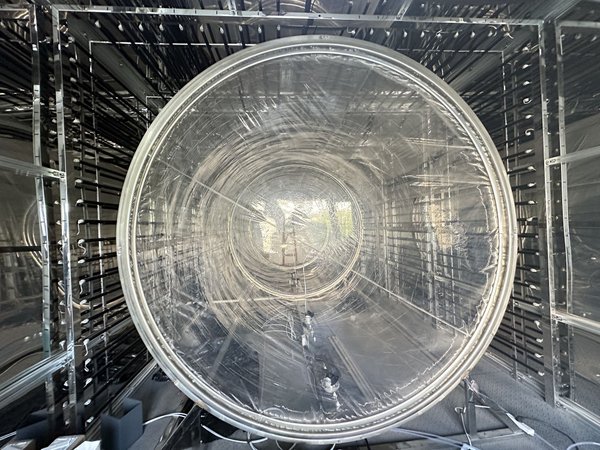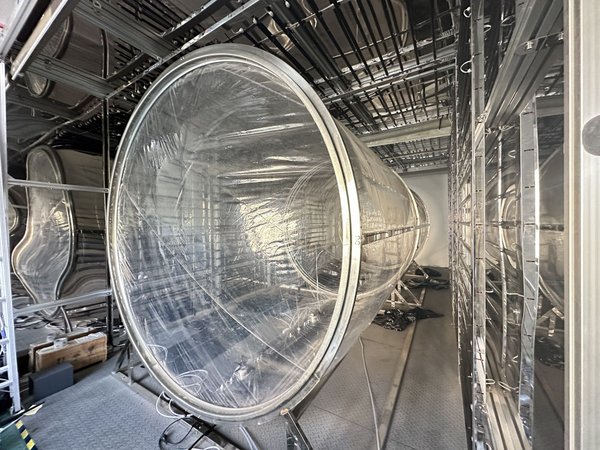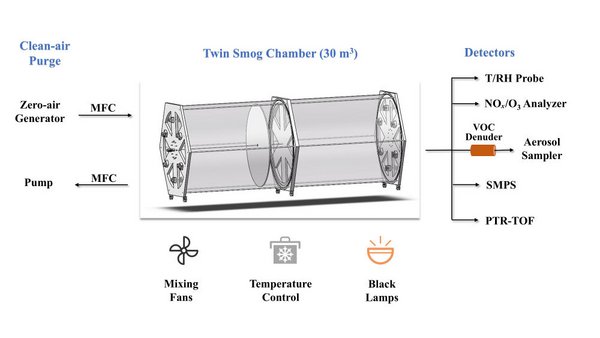More water vapour leads to more aromatic nitro compounds in particles
Shanghai/Leipzig,
13.10.2025
– HH / TA
International research team discovers new reaction mechanism that leads to more nitroaromatic compounds in particles.
Shanghai/Leipzig. Humidity plays a crucial role in controlling the content of nitroaromatic compounds (NACs) in airborne particles. This is the conclusion reached by an international research team led by Prof. Jianmin Chen of Fudan University in Shanghai, China. Gaseous water forms so-called water clusters (WCs), which reduce energetic barriers during gas-phase reactions and make this reaction pathway competitive even under atmospheric conditions. The new reaction pathway fills a knowledge gap on these widespread compounds that affect air quality, climate and health. The results have now been published in Science Advances, the open-access journal of SCIENCE.
Nitroaromatic compounds (NACs) are organic compounds that contain one or more nitro groups on a benzene ring. They are used technically in the manufacture of dyes, pharmaceuticals and explosives. However, they are also important for atmospheric chemistry and thus the global climate because the nitro groups they contain control the properties of the compounds. Aromatic nitro compounds can have significant health effects on humans or be toxic to plants.
Among those who collaborated on the study was Leipzig-based atmospheric chemist Prof. Hartmut Herrmann from the Leibniz Institute for Tropospheric Research (TROPOS). In addition to the Leipzig University, he also teaches at Fudan University in Shanghai and Shandong University in Qingdao, China. "The new findings underscore the importance of a previously underestimated reaction pathway that is very important for accurately describing the content of nitroaromatic compounds in atmospheric particles," explains Hartmut Herrmann. "Future atmospheric models should therefore take these water clusters and their effects into account in order to improve the prediction of the proportion of nitroaromatic compounds in particles, to better interpret existing field measurements and, last but not least, to better assess the health effects of such substances in particles."
Publication:
Haiping Xiong, Xiaoyu Liu, Chongwen Sun, Xiangyu Zhang, Xinming Wang, Jingxin Lin, Likun Xue, Xiaomin Sun, Xiaona Shang, Fangfang Ma, Hongbin Xie, Jingwen Chen, Gang Yan, Jiangbin Shu, Hongbo Fu, Lin Wang, Yinon Rudich, Christian George, Abdelwahid Mellouki, Defeng Zhao, Xinke Wang, Hartmut Herrmann, and Jianmin Chen. Atmospheric water cluster–catalysed formation of nitroaromatics as a secondary aerosol source. Sci. Adv. 11, eadv7805 (2025).) 8 October 2025 DOI: 10.1126/sciadv.adv7805
https://doi.org/10.1126/sciadv.adv7805
The research was funded by the Ministry of Science and Technology of China (no. 2022YF3701101), the National Natural Science Foundation of China (nos. 22336001 and 22476133), the Science & Technology Commission of Shanghai Municipality (nos. 21DZ120230 and 21230780200) and an Agilent Applications and Core Technology-University Research (ACT-UR) Gift Grant (no. 4606).
Contacts:
Prof. Dr Hartmut Herrmann
Head, Department of Atmospheric Chemistry, Leibniz Institute for Tropospheric Research (TROPOS) & University of Leipzig
Tel. +49-341-2717-7024
https://www.tropos.de/institut/ueber-uns/mitarbeitende/hartmut-herrmann
or
Tilo Arnhold
Public Relations, TROPOS
Tel. +49-341-2717-7189
http://www.tropos.de/aktuelles/pressemitteilungen/
Links:
Shanghai Key Laboratory of Atmospheric Particle Pollution and Prevention
https://shlap.fudan.edu.cn/shlapen/main.htm
The Leibniz Institute for Tropospheric Research (TROPOS) is a member of the Leibniz Association, which connects 96 independent research institutions. Their focus ranges from the natural sciences, engineering and environmental sciences to economics, spatial and social sciences and the humanities. Leibniz Institutes address socially, economically and ecologically relevant issues.
They conduct knowledge- and application-oriented research, including in the overarching Leibniz Research Alliances, are or maintain scientific infrastructures, and offer research-based services. The Leibniz Association focuses on knowledge transfer, especially with the Leibniz research museums. It advises and informs politics, science, business, and the public.
Leibniz institutions maintain close cooperation with universities – including in the form of Leibniz Science Campuses – with industry and other partners in Germany and abroad. They are subject to a transparent and independent evaluation process. Due to their national importance, the federal and state governments jointly fund the institutes of the Leibniz Association. The Leibniz Institutes employ around 21,300 people, including 12,200 scientists.
The total funding volume is 2.2 billion euros. They are jointly financed by the federal and state governments. The basic funding for the Leibniz Institute for Tropospheric Research (TROPOS) is provided by the Federal Ministry of Education and Research (BMBF) and the Saxon State Ministry of Science and the Arts (SMWK). The institute is co-financed from tax revenues on the basis of the budget approved by the Saxon state parliament.
http://www.leibniz-gemeinschaft.de
https://www.bmbf.de/ Atmospheric chamber at Fudan University in Shanghai
https://www.smwk.sachsen.de/



